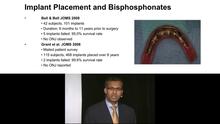-
0
Patient Assessment
- 0.1 Patient Demand
- 0.2 Anatomical location
-
0.3
Patient History
- 2.1 General patient history
- 2.2 Local history
-
0.4
Risk Assessment
- 3.1 Risk Assessment Overview
- 3.2 Age
- 3.3 Patient Compliance
- 3.4 Smoking
- 3.5 Drug Abuse
- 3.6 Recreational Drug and Alcohol Abuse
- 3.7 Condition of Natural Teeth
- 3.8 Parafunctions
- 3.9 Diabetes
- 3.10 Anticoagulants
- 3.11 Osteoporosis
- 3.12 Bisphosphonates
- 3.13 MRONJ
- 3.14 Steroids
- 3.15 Radiotherapy
- 3.16 Risk factors
-
1
Diagnostics
-
2
Treatment Options
-
2.1
Treatment planning
- 0.1 Non-implant based treatment options
- 0.2 Treatment planning conventional, model based, non-guided, semi-guided
- 0.3 Digital treatment planning
- 0.4 NobelClinician and digital workflow
- 0.5 Implant position considerations overview
- 0.6 Soft tissue condition and morphology
- 0.7 Site development, soft tissue management
- 0.8 Hard tissue and bone quality
- 0.9 Site development, hard tissue management
- 0.10 Time to function
- 0.11 Submerged vs non-submerged
- 0.12 Healed or fresh extraction socket
- 0.13 Screw-retained vs. cement-retained
- 0.14 Angulated Screw Channel system (ASC)
- 2.2 Treatment options esthetic zone
- 2.3 Treatment options posterior zone
- 2.4 Comprehensive treatment concepts
-
2.1
Treatment planning
-
3
Treatment Procedures
-
3.1
Treatment procedures general considerations
- 0.1 Anesthesia
- 0.2 peri-operative care
- 0.3 Flap- or flapless
- 0.4 Non-guided protocol
- 0.5 Semi-guided protocol
- 0.6 Guided protocol overview
- 0.7 Guided protocol NobelGuide
- 0.8 Parallel implant placement considerations
- 0.9 Tapered implant placement considerations
- 0.10 3D implant position
- 0.11 Implant insertion torque
- 0.12 Intra-operative complications
- 0.13 Impression procedures, digital impressions, intraoral scanning
- 3.2 Treatment procedures esthetic zone surgical
- 3.3 Treatment procedures esthetic zone prosthetic
- 3.4 Treatment procedures posterior zone surgical
- 3.5 Treatment procedures posterior zone prosthetic
-
3.1
Treatment procedures general considerations
-
4
Aftercare
Smoking
Key points
- Smoking has a vasoconstrictive effect, reduces blood supply and compromises wound healing.
- Smokers experience a significantly higher incidence of periodontitis, dry extraction sockets and post implant surgery complications.
- Smokers should be strongly advised to quit smoking completely or at least six weeks prior to implant surgery and other surgical treatment phases and ideally also after treatment completion in order to increase long-term success.
Effects of smoking and nicotine on treatment
Smoking and nicotine consumption have a constrictive effect on blood vessels thereby reducing blood supply. It increases the susceptibility to periodontal inflammatory diseases, dry extraction sockets and wound healing complications in general, including wound healing after implant surgery.
Smokers have a 2–4 times higher incidence of periodontitis, peri-implant mucositis and postoperative complications after tooth extraction and any surgical treatment. Smokers also have a higher incidence of osteoporosis, although this may be due to social and economical factors that predispose to both conditions independently.
Smoking patients should be informed about the negative effect smoking has on wound-healing and the reduced implant treatment success rates, especially in the upper jaw. They should stop smoking at least six weeks prior to and eight weeks after implant surgery. By doing so, patients can enjoy the same clinical success outcomes as non-smokers. In some instances, patients may quit smoking for good after this cessation.
It is also the role of any oral health care provider to inform the patient about the general risks of smoking: lung cancer, chronic obstructive lung disease, myocardial infarction (twice as often), osteoporosis, shorter life expectancy vs. lifelong non-smokers.


